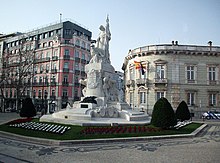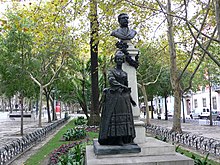Avenida Da Liberdade (Lisbon)
The Avenida links Marquis of Pombal Square in the north to Restauradores Square, the entrance to the Lisbon Baixa. It is commonly referred to by the inhabitants of Lisbon simply as the "Avenida" (the Avenue).
History


The Avenida da Liberdade, as well as the Restauradores Square, have their origins in the Passeio Público, a public park inaugurated in the area in 1764. A project led by Pombaline architect Reinaldo Manuel, the park was initially surrounded by a high wall. It was revamped in the 1830s and 1840s by architect Malaquias Ferreira Leal, who introduced a new arrangement of the flora as well as fountains, a waterfall and statues. The allegoric statues representing the Tagus and Douro rivers that still exist in the boulevard of the Avenida date from this time.
The Avenida was built between 1879 and 1886, modeled after the boulevards of Paris. It was planned to expand further north, through what is the present central lawn lane of the Eduardo VII Park. However, these plans were abandoned in the 1960s.
Many of the original buildings of the Avenida have been demolished in the last decades and replaced by modern office and hotel buildings. Nowadays, it is decorated with many monuments and statues that pay homage to important personalities like Almeida Garrett, Alexandre Herculano and others. The large monument to the fallen in World War I, inaugurated in 1931, is the work of Rebelo de Andrade and Maximiano Alves.
Luxury destination


Due to Avenida da Liberdade's central location and proximity to the prestigious locations and institutions, like the Chiado district, Marquis of Pombal Square, Queen Maria II National Theatre, the Avenidas Novas, Eduardo VII Park, the Lisbon Baixa, and numerous others, the avenue has long been considered the heart of Lisbon. It has become an international luxury destination for its shopping, hotels, and fine dining.
The Avenida is home to one of the largest concentrations of international luxury brands in Europe, including brands like Louis Vuitton, Prada, Christian Dior, Chanel, Versace, Balmain, Gucci, Givenchy, Yves Saint Laurent, Stella McCartney, Christian Louboutin, Dolce & Gabbana, Armani, Tod's, Ermenegildo Zegna, Molteni&C, and Burberry.
The Avenida is home to numerous luxury hotels, including those from the following groups: Sofitel, Tivoli Hotels & Resorts, Dom Pedro Hotels & Golf Collection, and Fontecruz Hotels, among numerous others.
Transportation
The Avenida is a major artery road in central Lisbon, connecting the Avenidas Novas to the Lisbon Baixa, Chiado, Bairro Alto, and more.
There are three Lisbon Metro stations along the Avenida:
- Restauradores at the southeast end, under Restauradores Square, served by the blue line.
- Avenida at about the midpoint of the avenue, served by the blue line.
- Marquês de Pombal at the northwest end, under Marquês de Pombal Square, served by the blue and yellow lines.
Gallery
-
Hotel Heritage
-
Monument to António Feliciano de Castilho
-
Luxury hotel
-
Monument to World War I
-
Monument to Alexandre Herculano
References
- ^ "Avenida da Liberdade property market in 2022 / 2023 - Prices per sqm meter to buy a home in Lisbon - Portugal". www.tagusproperty.com. Retrieved 10 September 2024.
- ^ "Avenida da Liberdade, Lisbon". www.golisbon.com. Retrieved 26 December 2024.
- ^ Gonzalo (19 August 2015). "Avenida Liberdade - Liberty Avenue". The Lisbon Guide - Updated 2024. Retrieved 26 December 2024.
- ^ Navarro, Chadner (6 July 2017). "A Guide to Avenida da Liberdade, Lisbon's Chicest Street". Vogue. Retrieved 10 September 2024.
- ^ "Avenida da Liberdade Guide". Portugal Confidential. Retrieved 10 September 2024.
- ^ Sena, Miguel (28 May 2024). "Italian Molteni&C arrives at Avenida da Liberdade with Cushman & Wakefield". Cushman & Wakefield. Retrieved 29 December 2024.
{{cite web}}: CS1 maint: url-status (link) - ^ "Diagrams and maps".







